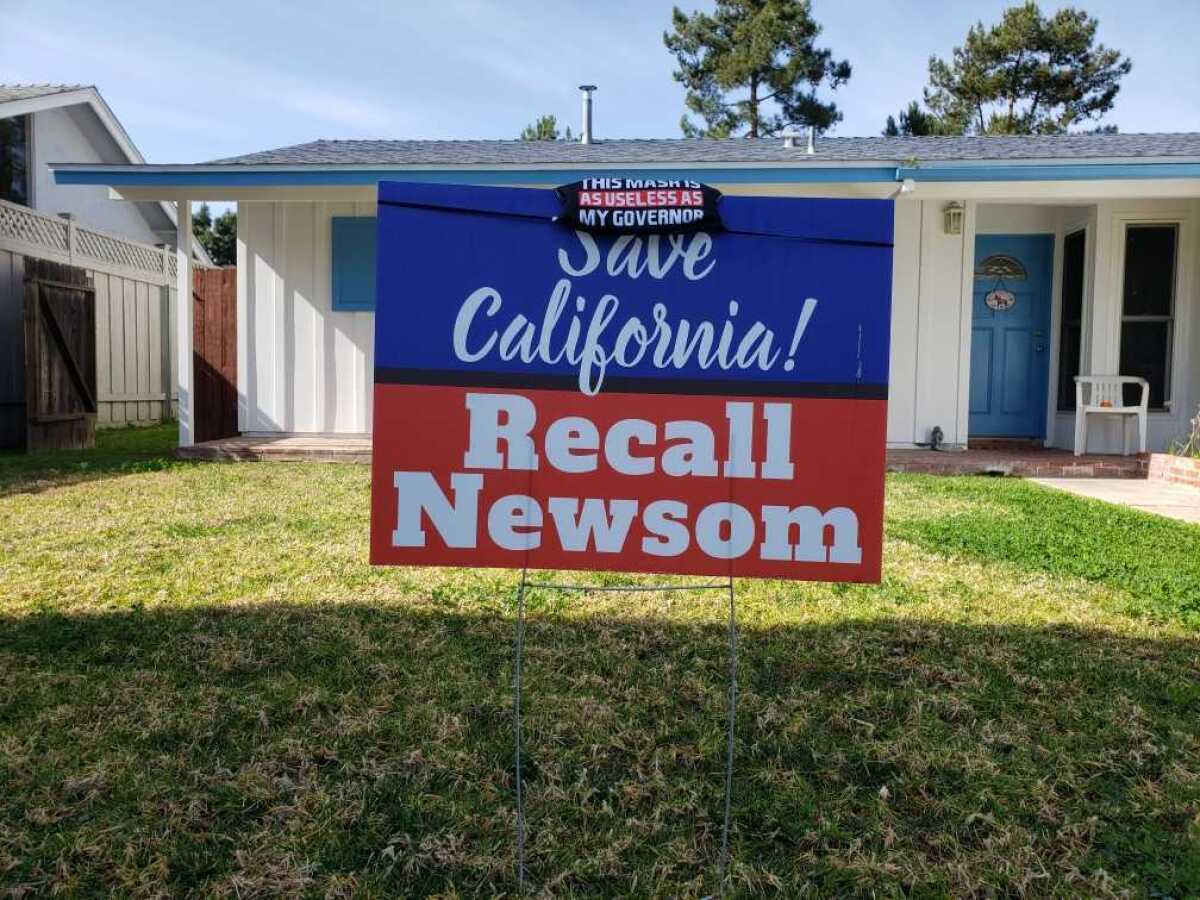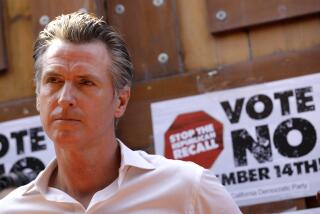Dump Gavin Newsom? Last time a California governor was recalled, it was a circus

- Share via
Just a year after I moved to the land of direct democracy in 2002, Gov. Gray Davis was unceremoniously booted out of office in a recall election that was more like a carnival sideshow than an exercise in self-government. On Oct. 7, 2003, California voters were asked not just whether they wanted to remove Davis — but which of 135 candidates on the ballot they thought should replace him.
Among those vying to succeed him were a former child actor, a pornographer, a sumo wrestler, an action hero, a couple of college students and some not terribly popular politicians. The action hero won, though he drew less than 50% of the vote in the crowded field.
It was not an inspiring moment for democracy. In many ways, it was a test run — no offense, Arnold — for the Trump election, which 13 years later reaffirmed that when faced with the most serious of decisions, Americans will often make inane choices and opt for fame and fantasy over substance. Looking on from abroad, the Guardian called the 2003 recall that brought Arnold Schwarzenegger to power “a circus fit for the fruit and nut state.” The Economist asked: “Is the Golden State governable?”
California Gov. Gavin Newsom will get a chance to swing for the fences during Tuesday’s event in trying to assure voters that his pandemic policies are working.
Now we may be cruising toward a repeat. By March 17, signatures will be submitted in support of recalling Gov. Gavin Newsom. If 1,495,709 of them are deemed valid (12% of the turnout in the last gubernatorial election), a vote will be scheduled — and all bets are off. Who knows who will run? Who knows who will win? Who knows how many zillions of dollars will be spent to promote any number of outrageous outcomes? Newsom could certainly triumph and hold on to his job — especially if he panders effectively to those he’s offended — but I wouldn’t bet the state Capitol on it.
Californians apparently like the recall system. Me? I’m not so crazy about it except as a last resort.
These days, seeking to remove officials from their jobs before their term is up is in vogue. In Washington, the U.S. House of Representatives twice sought to oust President Trump from office.
In California, Newsom is just one of many who have been threatened with a recall.
Los Angeles Mayor Eric Garcetti avoided one a year ago when opponents challenging his handling of the city’s homelessness crisis failed to gather the necessary 300,000 signatures.
Los Angeles County Dist. Atty. George Gascón was challenged by victims’ rights advocates so soon after taking office in January that state officials had to remind them that a recall can’t begin until an officeholder has served 90 days.
Chesa Boudin, San Francisco’s reformist district attorney, is facing a recall effort, too, even though he’s served for just over a year.
The Los Angeles County Board of Supervisors is looking into options for removing Sheriff Alex Villanueva, although it is not clear that a recall is their preferred approach. Around the state — in Shasta County, Ventura County and elsewhere — various supervisors and council members and sheriffs face efforts to remove them. In San Francisco, a formal effort to recall three members of the school board is underway.
Many of these efforts will no doubt fail to reach the ballot. But still, voters are jumping to the nuclear option awfully quickly — too quickly. If you don’t like Newsom, wait until the regularly scheduled election — next year! — to vote him out.
The recall became part of the California Constitution in 1911. But many believed it would be used sparingly. They hoped that the mere threat of removal from office would help keep officials in Sacramento accountable and honest and help unlock the grip of special interests, such as the Southern Pacific Railroad. The recall was a tool with roots as far back as ancient Rome, and had been used in parts of Switzerland since the 19th century.
“I do not wish to use the recall if it is possible to avoid doing so,” said Theodore Roosevelt, a supporter of the process. Woodrow Wilson also saw it as a safeguard: “It is seldom used outside the municipalities. I do not remember an instance of its use on a state officer. It is merely ‘a gun behind the door.’”
For the first 83 years in California, only three recall elections of state elected officials successfully reached the ballot. In the subsequent 27 years, it’s happened seven times.
Gray Davis was the first governor to be removed in California, and the second in the country’s history. Now we’re trying again.
In California, says Joshua Spivak, a senior fellow at the Hugh L. Carey Institute for Government Reform at Wagner College, it’s particularly easy to qualify a recall for the ballot. Eighteen other states have recall provisions, but some permit them only for specified reasons such as malfeasance or conviction of a crime or incompetence. In California, there are no such limitations.
Spivak says that nationwide, 60% of recalls that make it to the ballot result in removal of the challenged official.
It’s fine to have a fail-safe mechanism to deal with truly corrupt or incompetent or dangerous elected officials. But the rest of the time, let’s give our officials a chance to do the jobs they were elected to do. California’s process is too chaotic, costly and unpredictable to use on a regular basis every time voters are irked at a politician.
Gray Davis raised the vehicle license fee. Gavin Newsom made the harebrained decision to eat dinner at the French Laundry in the middle of a pandemic.
Those kinds of things get people riled up. But they don’t justify undoing an election.
More to Read
A cure for the common opinion
Get thought-provoking perspectives with our weekly newsletter.
You may occasionally receive promotional content from the Los Angeles Times.










